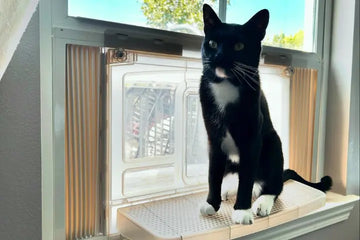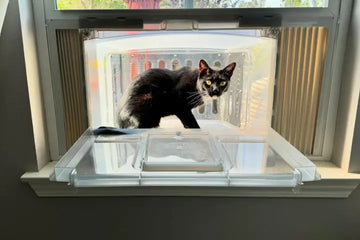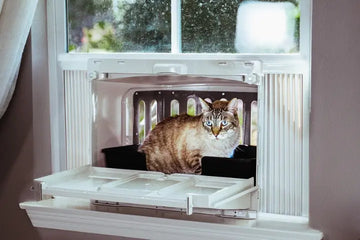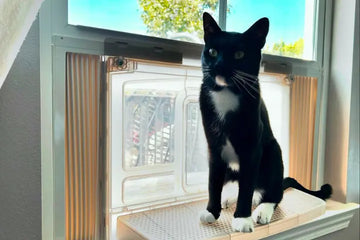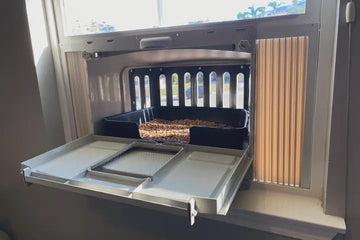Maintaining a clean and odor-free environment when you have cats begins with the proper management of their litter boxes. It's not just about keeping your home smelling fresh; it's also crucial for the health and well-being of your feline friends. Cats are known for their cleanliness and can be very particular about where they do their business. A poorly maintained litter box can lead to behavioral issues, such as avoiding the litter box altogether, which can result in unwanted messes around your home. Therefore, understanding and implementing effective litter box maintenance is essential for every cat owner.

Selecting the Right Litter Box
Criteria for Choosing
The ideal litter box should be large enough for your cat to move around freely. A general rule is that the box should be at least as long as your cat from nose to tail, plus half again. This size ensures that your cat has enough space to dig and cover their waste without spilling litter outside the box. Additionally, the sides of the litter box should not be too high for your cat to step over comfortably, especially for kittens or older cats with mobility issues.
Special Considerations
When choosing a litter box for kittens, it’s important to opt for one with lower sides to make it easy for them to enter and exit. Kittens are learning how to use the litter box, so accessibility is key to avoiding any accidents. For homes with multiple cats, it’s recommended to have more than one litter box to prevent overcrowding and stress among the cats. The general guideline is to have one litter box per cat, plus one extra. This ensures that every cat has access to a clean litter box at all times.
The Benefits of Self-Cleaning Litter Boxes
Self-cleaning litter boxes offer a revolutionary solution to one of the most challenging aspects of cat ownership: litter box maintenance. These innovative devices automatically sift and remove waste, drastically reducing the frequency of manual cleaning required. This feature is beneficial for a litter box for multiple cats, as it helps keep the litter box fresh throughout the day.
However, transitioning to a self-cleaning litter box requires some consideration. Cats are creatures of habit, and the noise and movement associated with these devices might initially be startling or intimidating. It’s important to introduce your cat gradually to the new litter box, allowing them time to become accustomed to its operation. Some strategies for easing this transition include placing the new box next to the old one without turning on the automatic features and then slowly introducing the self-cleaning function once the cat seems comfortable.
Design and Accessibility
Design and accessibility play significant roles in litter box for odor control. A well-designed litter box with easy access can encourage your cat to use it regularly, which is crucial for maintaining cleanliness. Some litter boxes come with built-in filters or ventilation systems that help minimize odors. The placement of the litter box can also impact odor control. For instance, a window litter box allows for natural ventilation, further reducing smells. Additionally, choosing a litter box that's easy to clean will encourage more frequent cleaning.
How to Clean a Litter Box
Determining the Ideal Cleaning Frequency
An optimal cleaning routine can significantly contribute to a happy and comfortable home for both you and your feline friends. To achieve this, it's crucial to adhere to a cleaning schedule that ensures the litter box remains inviting and odor-free. As a general guideline, consider the following steps to maintain the perfect cleaning schedule:
- Scoop Daily: The first step in maintaining a pristine litter environment is to remove clumps and solid waste every day. This daily maintenance is crucial as it prevents the build-up of unpleasant odors, which can deter your cat from using the litter box. Regular scooping not only contributes to a cleaner box but also a more hygienic home environment. By keeping the litter box appealing, you encourage your cat to continue using it, thereby avoiding any unwanted accidents around the house.
- Full Clean Weekly: A more thorough cleaning process should be undertaken once a week. This involves emptying the litter box and scrubbing it down with a gentle detergent and warm water. Such deep cleaning helps to remove any lingering odors and stains that daily scooping can't address. It's also an opportune moment to inspect the litter box for any signs of damage or wear that could affect its usability. Regular weekly cleaning ensures that the litter box remains a clean and safe place for your cat to use.
- Replace Litter As Needed: After the weekly clean, it's important to refill the litter box with fresh litter to the recommended depth. For clumping litter, a depth of about 2-3 inches is ideal, whereas non-clumping varieties may require a slightly thicker layer of 3-4 inches. This step is crucial in maintaining the effectiveness and functionality of the litter box. Fresh litter not only aids in odor control but also makes it easier for your cat to bury their waste, which is an instinct. Ensuring the litter is at the appropriate depth contributes to a more pleasant and hygienic litter box environment.
By taking these steps, you can ensure that your cat's litter box is always clean, which is essential for their health and happiness. Regular maintenance and care of the litter box are key to preventing odors and ensuring that your cat feels safe and comfortable using it.
Selecting the Right Type of Litter
Clumping litter has become a preferred choice for many cat owners due to its convenience in maintaining a clean litter box. Its primary advantage lies in its ability to quickly absorb urine and form solid clumps. This feature not only simplifies the cleaning process by making it easier to scoop out waste but also helps keep the litter box fresh for longer periods. It's important to recognize that cat preferences vary widely, and what works for one cat may not be suitable for another. Some cats may find clumping litter uncomfortable due to its texture. Non-clumping litter, on the other hand, is often softer and finer, which can be gentler on a cat's paws. This type of litter does not form clumps and may require more frequent cleaning and replacement to maintain freshness, but its texture can be more appealing to certain cats, making it an important alternative for pet owners to consider.

For those particularly concerned about odors, the market offers a variety of specially formulated litter designed to combat this issue. Many of these products incorporate natural odor absorbers such as baking soda or activated charcoal. Baking soda works by neutralizing acids and bases, therefore eliminating odors, while activated charcoal absorbs odors and moisture, preventing the growth of bacteria that can cause bad smells.
The Use of Safe Cleaning Agents
Many household cleaners contain chemicals that can be harmful or irritating to your furry friend. Instead, opt for cat-friendly detergents or a mixture of warm water and vinegar. This natural solution effectively removes odors without leaving behind any residue that could harm your cat. For a deeper clean, baking soda can be sprinkled into the litter box before adding new litter, offering an extra layer of odor protection that's both safe and natural.
Advanced Solutions for Odor Control and Cleanliness
Window Litter Boxes
These boxes are placed near or in a window, drawing in fresh air and expelling stale, odorous air. Beyond improving air quality, window litter boxes can provide your cat with a stimulating view of the outdoors, promoting mental health and reducing stress. This innovative approach to litter box placement not only addresses odor concerns but also enriches your cat’s living environment.
The Concept and Benefits of Window Catios
A window catio extends the idea of the window box for cats, offering a secure outdoor space that allows your pet to enjoy the outdoors safely. These enclosures can be connected to a window litter box, facilitating an area where your cat can relieve themselves and then bask in the sun or watch birds. The natural airflow through the catio helps dissipate odors, while the outdoor exposure provides environmental enrichment for your cat.
Innovative Litter Types and Accessories
Innovations in this area focus on enhancing odor control, simplifying the cleaning process, and providing environmentally sustainable options. Here's a closer look at some of the groundbreaking products that have emerged in the pet care market:
- Biodegradable Litters: These litters are a boon for environmentally conscious pet owners. Made from renewable resources like recycled paper, wood pellets, or corn, biodegradable litter is not only gentle on the planet but also offers impressive odor control capabilities. They break down naturally in the environment, reducing landfill waste. Additionally, these litters are often softer on your cat's paws, making them a comfortable choice for sensitive pets. Their natural materials are adept at absorbing odors, ensuring your home stays fresh.
- Silica Gel Litters: Silica gel litters stand out for their superior absorbency and ability to trap odors and moisture upon contact. This type of litter is made from tiny crystals that can absorb a significant amount of liquid relative to their size, keeping the litter box dry and preventing the growth of bacteria that cause bad smells. Silica gel litters are virtually dust-free, making them an excellent choice for both the respiratory health of cats and their owners. Their low maintenance and long-lasting freshness make them a popular choice among busy pet owners.
- Litter Box Liners: Litter box liners are designed to make the cleanup process as hassle-free as possible. By lining the litter box with these liners, pet owners can quickly and easily remove all the litter at once without having to scrub the box. This convenience saves time and effort, making it a preferred choice for many. Litter box liners are especially useful for those who use non-clumping litter, as they can simply lift and dispose of the waste along with the liner, ensuring a clean litter box with minimal effort.
- Odor Neutralizers: Odor neutralizers, available as sprays or powders, are formulated to tackle unpleasant smells without the use of harmful chemicals. These products can be applied directly to the litter, where they work to neutralize odors on a molecular level, leaving the litter box smelling fresh. They are an excellent complement to regular cleaning, providing an extra layer of odor control that is safe for both pets and humans. Odor neutralizers are a simple yet effective way to maintain a pleasant environment around the litter box.
The introduction of these innovative litter types and accessories marks a significant advancement in pet care, offering solutions that cater to the needs of both pets and their owners. By choosing the right products, pet owners can ensure a clean, odor-free home and a comfortable, hygienic space for their cats.
Strategic Placement Within the Home
Considering Cats' Privacy and Accessibility
Cats have a natural inclination for privacy when doing their business, much like humans. Therefore, the litter box should be placed in a quiet, low-traffic area where your cat feels secure. Yet, it's equally important to ensure the box is easily accessible at all times, including at night. Avoid locations with loud noises or heavy foot traffic, which can startle your cat or deter them from using the box.
Balancing Aesthetic Concerns with Practicality
While it's important to keep odor control and your cat's preferences in mind, the litter box's impact on your home's aesthetics is also worth considering. Innovative litter box designs can blend seamlessly with your home decor, acting as functional pieces of furniture. For example, litter boxes concealed within cabinets or planters provide an attractive solution that hides the litter box in plain sight. This approach allows pet owners to place the litter box in more central locations without compromising the home's visual appeal.
Managing Cat Waste Effectively
Environmentally Friendly Disposal Methods
Biodegradable bags offer a sustainable choice, breaking down more quickly in landfills compared to traditional plastic bags. Composting is another eco-conscious option, although it should be done with caution and only for waste without litter, as cat feces can contain harmful pathogens. These green practices not only help in reducing your carbon footprint but also ensure that the process of managing cat waste aligns with broader environmental goals.

Routine Checks and Maintenance Tips
Inspecting the box for cracks or damage that could harbor bacteria and cause leaks is essential. Similarly, replacing the litter box entirely every year or so can help in controlling odors that might have seeped into the plastic over time. Regularly updating your cat's litter box and the surrounding area with these considerations in mind ensures ongoing cleanliness.
The journey to maintaining an optimal litter box environment is ongoing. Continuous improvement, driven by regular monitoring of your cat's preferences and behavior, along with staying updated on new products and solutions, can enhance the litter box experience. Engaging with your cat and making adjustments based on their needs ensures a clean, odor-free home and a happy, healthy pet. Embracing these principles and practices paves the way for a harmonious living environment for both cats and their owners, now and in the future.



